|
Beirut, 15 October, 2006
by Walid Noshie
Lebanon has lots of sites that makes it if not for the
visibility and lack of corals, one of the most interesting places in the world,
not by its many site, but for the quality of marine life and its wrecks. Link to
wreck photos. Here are some the good sites discovered so far, making Lebanon a
very interesting diving location for both locals and travelers. It will give you
an idea on the best times to visit certain sites, how to get there, and what to
expect on that specific dive.
DIVE SITES & TALES IN LEBANON is an essential guide for
divers of all levels of experience. This practical link offers detailed
information on dive sites. It gives the background of some spots on the Lebanese
coast, the history on certain locations, and it recounts a few dive tales.
DIVE SITES IN BEIRUT
AUB CANYON
 Location:
Facing American University Beach Location:
Facing American University Beach
Getting there: By car or boat
Finding Site: easy
Access and condition: Boat is ideal but shore entry
from AUB beach or from the Cornish is possible. Rocky but easy entry, rocky
bottom. Some wind and waves possible, watch out for sea urchins on entry
Depth of dives: Rocky bottom starts at 5m, drop-offs
down to more than 300m
Level: This site is suitable for all standards of
divers, beginners to technical
Best time to dive: October to June for a good
visibility. Jelly fish concentration in July and August, making the site
hazardous
Quality of marine life: Diverse; moray eels, octopus and groupers; lobsters in
April
Visibility: 6-20m, rain and river run-off effect the
visibility. Excellent spot for night diving when visibility is good, all marine
life out of the rocks feeding including flute fish, sting rays and Spanish
dancers
FACTS
AUB Canyon was one of the best diving spots known in the
60’s. It used to be called the Sharks hole since fishermen used to catch sharks
from the deep end of the canyon. Nowadays sharks are almost nonexistent on that
spot any longer. But on a calm and sunny day in winter with a soft north wind
and a good visibility, divers might find this spot an extremely interesting
site.
The canyon walls start at a depth of 25m and drop to more
than 300m. The walls on this reef are steep, beautiful, full of small caves and
fishermen's nets, with a huge old anchor laying at 43m. Having a dive light
surely will make your dives on that spot much more interesting. Remember that
when you start exploring the walls of that canyon, a relative good diving
experience and a dive leader familiar with that spot would be a great asset.
SHARK POINT
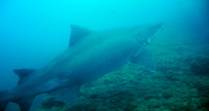 Location:
1.5Km. South-West of Rawche Location:
1.5Km. South-West of Rawche
Getting there: by boat
Finding site: easy with the use of a line or anchor
Condition: Strong wind, waves and currents all
possible
Depth of dives: Rocky bottom starts at 28m. drops to
50m
Level: This site is suitable for experienced
advanced divers
Quality of marine life: diverse and rich. Best in
the whole country, although best between April and September. Moray eels, sting
ray in groups, Eagle rays, groupers but best of all is the sharks. The
Small-Tooth Sand Tiger and the Gray Nurse sharks. These sharks will start
showing up in July and will disappear again in October, to come back again same
time the year after
Visibility: 10-25. Good year round although affected
by currents and plankton blooms
FACTS
Shark point is an area composed of 5 reefs, which includes
some plateau sections and a deep canyon running along every reef towards the
East. Crossing 1 reef to the other towards the North is sand beds in between
making the passages look like huge corridors. Getting to the third reef, divers
will admire a statue of a Lebanese saint praying above a small cave which sting
rays take refuge in. Crossing to the 4th Reef, comes the site of a vertical
wall, with a rugged profile full of fissures, inlets and crevices to explore.
Getting to the 5th reef towards the East is where most sharks were observed.
Divers should be careful of the strong north-west currents which are very common
in this area in the summer season, to avoid being completely swept off the Shark
point.
TALES
The year 1981, I was on a normal dive with my brother on a
land I have just discovered few days earlier. We were moving on the higher
plateau wanting to extend our dive time. Depth was 27m. Few minutes later I
realized that in order to see more marine life, we had to drop to 34m to be able
to see the lower part of the wall. The visibility was not excellent that day.
Moving towards the bottom, the sea bed came to sight. With it came a huge shark
moving strait towards me. There was no place for fear since that huge animal was
only 2 m. away from me. My brother until then had seen nothing since he was
still on the plateau getting ready to follow me. I grabbed the wall and started
climbing back upside down until I reached my brother and I warned him on what's
below. He moved cautiously to the limit of the wall and here was the shark
passing at a speed of 4 km per/hr. looking towards us as curious as we were. The
sight was awesome, we've been diving 3 years already my brother and I and nobody
ever mentioned the existence of any sharks in our waters. We thought that this
was a coincidence yet every year we saw the sharks again and sometimes they were
many, up to 5 sharks around us in one dive. With more studies on the behavior of
these sharks and after few hundred dives on that site came the sure conclusion
that these animals would come to that same spot every year, stay around for 2
months and leave again. (all the site measures not more than few hundred sq.
meters.). Start the dive 20 m. away from that spot and you won’t see any sharks
at all. There came the site's name. Shark Point.
SMALLTOOTH SAND-TIGER ODONTASPIS FEROX
A shark with a robust body and a long, conical snout, the
eyes are medium large, the mouth is well developed, with teeth consisting of a
central cusp and two or three small lateral cusps. There are two dorsal fins,
the first of which is well developed. The tail is heterocertal, but with a
developed bottom lobe. The coloring is grayish, and paler to white on the belly.
It usually lives in deep waters or near the sea bed, between 15 and 420 meters
deep. Regional feeding ecology is poorly known, but available data on stomach
contents demonstrate a primarily piscivorous diet of small bony fishes, squid
and shrimp, (also seen feeding on a sting ray by local divers). Assumedly
ovoviviparous, but no reproductive data, males measure up to 300 cm. while
females reach 400 cm. At birth, size is over 105 cm. Long. It is found in the
Mediterranean, the east Atlantic and the Indo-Pacific (Madagascar, South Africa,
Australia, Japan, Hawaii and California).
Despite the name FEROX, this shark has never been accused
of attacking people. Divers are advised to move and behave cautiously when the
sharks are sighted during the dive. Divers should never attempt touching the
sharks. Just stay calm and enjoy the show. Remember that all sharks are
predators and will attack and bite if felt threatened.
Gray nurse - Eugomphodus Taurus
Also seen on shark point, had a bad reputation in the old
days as a man-eater in Australia but this was due to confusion with other sharks
as it is inoffensive unless provoked. Popular aquarium species because its
fierce look. Very similar look to the ferox. Groups sometimes herd schools of
prey.
THE “SOUFFLEUR”
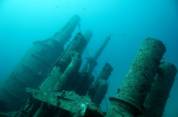 Location:
12 km south of Ras-Beirut Location:
12 km south of Ras-Beirut
Getting there: By boat from Beirut
Finding site: Difficult
Condition: Current, waves and wind can all be
considerable
Depth of dive: Average 34m to a maximum of 38m
Level: This site is suitable for experienced
advanced divers
Best time to dive: Good year round, best in spring
and fall
Quality of marine life: Diverse, Sting rays, moray
eels and eagle rays
Visibility: 6-25m year round affected by currents
and plankton blooms
Historical interest: High
Documents: Souffleur. Souvenirs D'un Sous Marinier au Liban
durant la seconde guerres mondiale (link as old web)
FACTS
The "SOUFFLEUR" can be ranked among one of the best WW2
wreck in the world. The site is suitable for divers with some good experience
and the level of expertise increases as conditions and visibility deteriorate
and they do so frequently. Check for currents, wind and waves action, and decide
if the conditions match your skill level. Dives generally begin at the bow deck,
where downline will be secured. Descents and ascents should always be made along
the line to avoid being swept off by currents.
The "SOUFFLEUR", a French submarine sank in battle during
WW2., with 50 men of its crew, lies cut in two at 38m. of sandy bottom, the
stern laying on its left flank and the bow on its right. Torpedoed by the
English submarine "PARTHIAN", in the midsection under its 105 mm. Canon, was the
epicenter of the blast that sank the Souffleur and it is badly damaged. The rest
is pretty much complete. The main anti-aircraft gun lies broken with its stand
on the sandy floor. Same goes for its 105 mm. Canon, lying 150m away from the
submarine. Divers will find plenty of open holes caused by old-time fishermen's
dynamiting the site for fish. These holes look very tempting for a discovery
penetration, but divers beware from any penetration attempt, since passages are
very narrow and silt will immediately cover your trace making entry extremely
hazardous and life threatening.
HISTORICAL FACTS
Nine "shark" type submarines were built between 1924 and
1928. Building of the "SOUFFLEUR" began at Cherbourg on October 1st, 1924 and
terminated in 1926. Length: 78.25m, beam: 4.52m, displacement: 1,147 tons
(surfaced) 1,438 tons (submerged), power: 2,900 diesel HP. And 1,900 electric
HP. Speed: 16 knots (surfaced) and 10 knots (submerged). Armament: ten 550m/m.
Torpedo tubes (4 forward, 4 external and 2 aft), one 100m/m canon and a 20m/m
double machine gun. Crew: 54 men.
On March 20, 1940 lt. Commander Bazoche commanding the "SOUFFLEUR",
was replaced by its new and last captain, lt. Commander Lejay.
After the fall of France in that same year, and under the
new Vichy government, the "SOUFFLEUR" and two other submarines of the same type,
"CAIMAN" and "MARSOUIN", departed on April 1st. 1941 to Beirut to join the Navy
division of the Levant.
The three submarines started their patrols along the
Lebanese and Syrian coast until June 8, 1941, when the British and the Free
French Forces launched their attack against Syria and Lebanon.
On that day, the "SOUFFLEUR" was operating in Tyre region.
Between the 8th and 11th of April, he participated in his first battle mission,
attacking 3 British destroyers (unknown result), and getting attacked himself
with depth charges. Back to base on April 11, 4 P.M.
The "SOUFFLEUR" goes again on new missions from April 14
until the 18th, and again from April 20 until the 21st.
On April 24th, he goes on his last mission. On April 25, at
12.55 P.M. the "SOUFFLEUR" was on the surface, 3 Km off Khaldeh, running on one
engine, trying to recharge his batteries after and agitated night. 4 torpedo
lanes appeared coming from the west. Lt. Morange who was on the surface command
with 5 other men, maneuvered to avoid the torpedoes which 1 hit the submarine's
middle section. The "SOUFFLEUR" broke in two instantly. The other 3 torpedoes
went to shore of which 1 exploded, and two were found intact.
Lt. Morange, most likely gravely wounded, sank with the
submarine. The other 5 sailors who were on the deck tried to reach the coast: 4
succeeded after swimming for 3 hours, the fifth sank on the way.
Commander Lejay died that day with forty nine other
crewmen.
The "SOUFFLEUR" was torpedoed by the British submarine
"PARTHIAN".
The "PARTHIAN" hit a mine and sank with its crew on August
10, 1941, 50 days after it sank the "SOUFFLEUR".
On July 10, 1941, the allied forces took over all Lebanon
and Syria.
From The 9th Division of the Levant came these words about
the submarine "SOUFFLEUR":
"Gloriously lost on June 25, 1941 on the Syrian coast
during a war operation".
MORE FACTS, PERSONAL OBSERVATIONS & CONCLUSION
It appears (previous and numerous correspondence from Com.
Lt. Lejay to the general headquarters, that I personally read) that this type of
submarine had a major factory defect. Any time they had to maneuver up and down
during combat, the "shark type" would loose its battery power in a alarming
speed. This would cause a premature surfacing to recharge the batteries. This is
most likely what happened on June 25, 1941.
From the report given by the 3 sailors that returned to
base, ( the fourth sailor, deserted to join the allied forces), They mention
that they had a very rough night. They were in no position to give more details
since their captain would not speak to all his sailors detailing all what was
happening.
Analyzing these circumstances, it proves that Com. Lt. Lejay had to make a
drastic decision that day. His batteries empty, he faced suffocation under the
sea or a mid-day surfacing, knowing that he could be hunted down. We all know
the rest of this sad story.
TALES
The year 1963, Abu Hsein, fishermen, takes his boat with
his aid and air compressor and moves to Khaldeh area, looking for sponge. His
aid Ahmad takes the air hose and dives for the search of the sponge. Instead he
comes across a submarine wreck and while Abu Hsein is sitting on the boat, he
sees Ahmad emerging from the water screaming: Submarine…Submarine. By the time
Abu Hsein realized what they have found, the current has swept their boat away
and while they continued diving that day, they could not relocate the submarine
anymore. Dreaming of a treasure waiting to be picked up, they decide to keep the
discovery a secret and starting the next day, the search begins with high hopes
and dreams. The search continued unsuccessfully for 10 days. Tired and
discouraged, Abu Hsein decided to follow a new search technique. He drops his
fishing net around the location where they approximately encountered the
submarine and started closing the circle. Suddenly something gets hooked. Diving
again on the spot, they find the submarine laying in the water cut in two
waiting to be explored.
With the little knowledge and experience they had, all they
could pick up was some good amount of brass they were able to brake from the
outer shell of the submarine, and sell it to the scrap brass market. But this
task was difficult and time consuming. After 3 month of brass stealing, they
realized that there was nothing more for them in the submarine since entry
looked impossible and hazardous. There was another way to make more money, and
that was the big amount of fish living in and out of the submarine. Since the
fishing net would cut from the sharp edges of the wreck, they used the dynamite
as a mean of fishing. Their plan succeeded and for over 2 years, Abu Hsein and
Ahmad were the only people that knew the location of the submarine. The secret
could not be kept any longer and later divers started exploring this great find.
MORE TALES
General Rohayem was a 7 years old kid in 1941, living in
Khaldeh. On June 25, Gen. Rohayem was talking a walk with his grandfather.
Suddenly the grandfather sighted the surfaced submarine far away in the sea. He
shows it to his grand son, and while Gen. Rohayem was looking at it in
admiration he sees it exploding and sinking an less than 30 seconds. This story
remained in his memory until today.
THE “MACEDONIA”
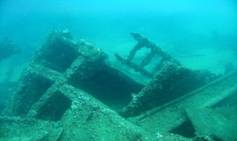 Location:
500m north-west of Rawshe Location:
500m north-west of Rawshe
Getting there: By boat; shore entry from Sporting
beach club possible
Finding site: Easy
Condition: Currents can be considerable. Diving drop
zone 50m south of the sight if suspecting currents. No diving when the wind is
strong and the waves are high
Depth of dive: Average 12m. to a maximum of 17m
Level: This site is suitable for all levels
Best time to dive: spring and fall, although
possible year round in calm weather
Quality of marine life: Good density and diversity
of schools of fish, moray eels and octopuses
Visibility: 8-20m, best in April and May. North-west
winds effect visibility and produce strong currents the rest of the year
Historical interest: Low
FACTS
The "MACEDONIA" was a cargo ship sailing regularly between
Egypt and Lebanon in the early 1960’s. On a stormy night, sailing too close to
shore, the Macedonia hits the shallow reef off Rawshe making a huge hole in its
entire front lower hull. Macedonia started taking water and its sailors were
able to content the water entrance for few days, until all its cargo was moved
to shore. The crack was so big that it was impossible to move the ship to
harbour for repair. Later it was sold to an individual who broke the ship in
pieces and sold as Scrap. The job could not be finished as a storm came one
night and brought the remaining of the Macedonia all down to the bottom.
The remaining of this wreck is cut in two, 1 part laying on
the sandy side of the reef and the other part is on the rocks.
The wreck is fairly well colonized by different species of
fish, including groupers and lobsters in the spring season.
TALES
Amazingly enough, the scrap was sold to the same person who
discovered the submarine wreck "SOUFFLEUR" while looking for the sponge.
THE “LESBIEN”
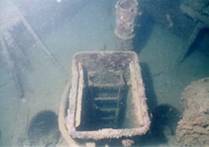 Name:
Lesbien Name:
Lesbien
Location: Beirut, 2 km from shore, north-west the
port of Beirut
Finding site: Easy with GPS
Condition: Current, waves and wind can all be
considerable
Depth of dive: 60 from 75 meters
Level: This site is suitable for experienced
technical divers
Best time to dive: Good year round
Quality of marine life: Diverse marine life
Visibility: 10 m year round affected by currents and
plankton blooms
Historical interest: Low
The Lesbian, is a British freighter facing Beirut
commercial port, lies intact and hardly ever visited except by few technical
divers at a depth of 60 meters after being blown by the French Vichy Navy during
WWII. It is an impressive sight, to hover above the mast of those ships,
descending slowly and landing around their decks. Marine life is especially
abundant on some of these artificial reefs.
1st Incident: June 1940, she was captured at Beirut harbor
by the French Vichy authorities.
2nd Incident: June 1941, she was badly damaged by the
bombings during the British offensive against Vichy troops in Syria and Lebanon.
14th of July 1941- After the surrender of Vichy troops to the British, the
Lesbian who was damaged beyond repair was sunk in deep water to avoid blocking
Beirut Harbor.
THE TUNNELS
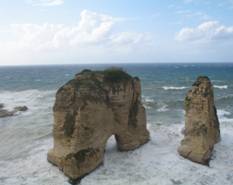 Location:
north-west of Rawche, 100m west of the wreck "Macedonia" Location:
north-west of Rawche, 100m west of the wreck "Macedonia"
Getting there: By boat
Finding site: Easy
Conditions: Currents and waves can be considerable
Depth of dive: Average 15m to a maximum of 20m
Level: This site is suitable for all levels
Best time to dive: year round in calm weather
Quality of marine life: Diverse. Moray eels,
octopuses, groupers as well as turtles
Visibility: 6-20m north wind will reduce visibility
and produce strong currents
FACTS
This site is a crack in the rock towards the west, 7m wide,
100m in length, making it look like a passage between 2 walls. Marine life is
pleasant, with a reef fish population that seems concentrated on this small spot
by these favorable conditions.
STRING RAY REEF
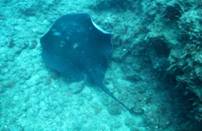 Location:
500m north-west from the military beach of Beirut Location:
500m north-west from the military beach of Beirut
Getting there: By boat
Finding site: Easy
Condition: Possibility of wind and waves on the
surface
Depth of dive: Average 22m to a maximum of 31m
Level: This site is suitable for experienced
advanced divers
Best time to dive: Year round except jelly fish
season. June and July best for Ray season
Quality of marine life: Diversity of fish and rays
Visibility: 5-20m year round affected by currents
FACTS
The dive site encompasses a wide, oval sloping patchy reef
which extends to the west of the circular reef top. The reef composition is
quite varied, with patchy sections in sand beds. Fish life is not great, but in
June an July, the sand beds and reef bottom crevices will surprise you
throughout the haul dive. It is not unusual that divers encounter as much as 10
rays in a single dive. From sting rays to electric rays to Thornback rays and
even Eagle rays; all encountered on that reef.
The reef slope is suitable for relatively inexperienced
divers while more experienced divers will enjoy the incredible experience of
seeing such a diversity of rays.
THE “CHAMPOLLION”
Location: 150m facing Miami Beach at Ouzai
Getting there: Shore or boat dive possible
Finding site: Easy
Condition: Site most covered by the new built
airport runway.
Depth of dive: Average 8m to a maximum of 11m best
time to dive: year round on calm weather
Quality of marine life: Below average. Octopus to
eels to different kind of fish
Visibility: 3 to 20m best on north wind days
Historical interest: High
PRESENT STATUS: This dive no longer exists as a new
airport runway has been built over the wreck
DIVE SITE NORTH OF BEIRUT
THE “ALICE B”
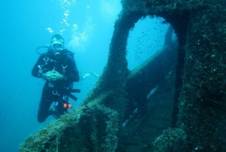 Location:
1 km north-west of ATCL in Jounieh Location:
1 km north-west of ATCL in Jounieh
Getting there: By boat
Finding site: Difficult
Condition: Well protected, mild underwater current
possible
Depth of dive: Average 34m to a maximum of 38m
Level: This site is suitable for experienced
advanced divers
Best time to dive: year round in calm weather
Quality of marine life: Schools of tuna, groupers
and Lobsters
Visibility: 4m-25m best on a very mild north wind
Historical interest: Low
FACTS
Although the wreck of the ALICE B is not old, on a good
visibility dive, it is very interesting and exceptionally photogenic for
underwater photography divers.
The ship is resting on the flat bottom, 38m from the
surface.
Divers can start exploring the stern which gives access to
the sleeping quarter and engine rooms. Starting at the main control room, the
area is wide and accessible by most divers. Behind it, come the kitchen and the
living quarter. From there divers will notice a hatchway that leads to the
bedrooms then to the engine rooms. Since plunderers have removed anything of
value, rooms are now completely empty except from their beautiful potholes.
While exploring the ship’s interior, take care to move
cautiously; you can easily kick up clouds of suspended particles, reducing the
visibility to a dangerous level. Divers are suggested to be specialized in wreck
penetration before attempting entry to any section.
TALES
During the bad days of the civil war in Lebanon in the
80’s, a group of militias, ordered by their leaders, blow 2 holes in the ship’s
stern and bow’s section in order to cash its insurance policy. Alice B was
declared lost at sea to the insurance company and all the coverage money was
collected; one million U.S dollars. At that time, It was a great loss for the
insurance company and a great find for that militia. Nowadays, it is definitely
a great dive and site to all divers.
TORO NEGRO - OIL TANKER
Location: north-west of Jounieh
Getting there: By boat
Finding site: Difficult
Condition: mild underwater current possible
Depth of dive: 19 to a maximum of 32m
Level: This site is suitable for experienced divers
Best time to dive: year round in calm weather
Quality of marine life: Rays, groupers and Lobsters
Visibility: 4m-25m best on a very mild north wind
Historical interest: Low
DIVE SITES IN TRIPOLI
TORPEDO CARRIER BOAT
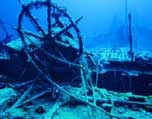 Name:
Unknown Name:
Unknown
Location: Tripoli 4Km facing the Fishing Port
Finding site: Easy with GPS
Condition: Current, waves and wind can all be
considerable
Depth of dive: average 60m. Maximum of 62m
Level: This site is suitable for experienced
technical divers
Best time to dive: Good year round, best in spring
and fall
Quality of marine life: Diverse marine life
Visibility: 15-30m year round affected by currents
and plankton blooms
Historical interest: High
FACTS
The name of this wreck remains a mystery even after deep
research. This ship was used as a Torpedo Carrier supplying the Vichy submarines
with torpedoes in the open sea. The ship was sunk after receiving a direct hit
either from an allied ship canon or bombed from an airplane.
On a good visibility dive, it is very interesting and
exceptionally photogenic for underwater photography divers, about 10 submarine
torpedoes laying; on the deck.
The ship is resting on the flat bottom, 60m from the
surface.
Divers can start exploring the stern which gives access to
the sleeping quarter and engine room. Starting at the main control room, with an
upper Deck where the steering remains intact.
The ship’s interior, is very narrow and difficult to
explore even for the most experienced Technical Wreck Instructor.
HMS VICTORIA
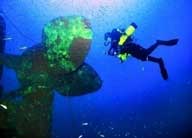 Name:
HMS Victoria Name:
HMS Victoria
Location: Tripoli, 16 Km north-west
Finding site: Easy with GPS
Condition: Current, waves and wind can all be
considerable
Depth of dive: from 75 m to 146m
Level: This site is suitable for experienced
technical divers
Best time to dive: Good year round, best in spring
and fall
Quality of marine life: Diverse marine life
Visibility: 15-30m year round affected by currents
and plankton blooms
Historical interest: High
FACTS
Built at Elswick and launched in 1887, the HMS Victoria was
the flagship in the Mediterranean of Admiral Sir George Tryon. Part of the
Victoria Class turret ship of the Royal Navy, the HMS Victoria was rammed and
sunk by HMS Camperdown on the 22nd of June 1893 during a maneuver preceding the
anchoring, in formation, of the 10 battleships fleet in Tripoli.
Admiral Tryon intended the maneuvers and the anchoring to
be an impressive sight to the entire British Navy fleet; unfortunately, the
maneuver went wrong and the two battleships met halfway. Camperdown struck the
Victoria on the flagship's starboard side, opening up an enormous hole at and
below the waterline. Victoria's bow went down and the stern rose with the
propellers still turning. The ship sank Only 13 minutes after the collision,
rushing towards the bottom.
Today, the HMS Victoria is resting at the bottom in a
vertical position with the stern upwards starting at 75 meters.
FACTS
One local dive instructor claims that he discovered the
wreck. His story is far from the truth since the wreck’s whereabouts was always
known from all the local fishermen.
More dive sites will be added when they will be completed
and edited by the author
|